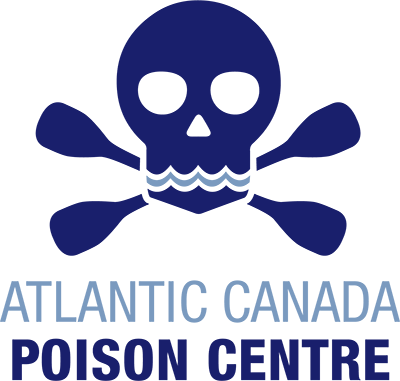
Atlantic Canada Poison Centre
Antidote Kit Manual
Fomepizole
Antizol®, 4-methylpyrazole, 4-MP
Indications
- Suspected or confirmed ethylene glycol or methanol poisoning.
- Exposure to other substances metabolized by alcohol dehydrogenase (diethylene glycol, glycol ethers).
-
Adjunctive treatment for massive acetaminophen overdoses; requires consultation with the poison centre.
Dosage
- Initial dose: 15 mg/kg IV over 30 minutes.
- Maintenance Doses (No hemodialysis): 12 hours after the initial dose, administer 10 mg/kg IV over 30 minutes every 12 hours for 4 doses if needed. Additional doses require an increase to 15 mg/kg IV every 12 hours. Continue until criteria for discontinuation are met: normal acid-base status, ethylene glycol level less than 3 mmol/L or methanol level less than 6 mmol/L. All doses to be infused over 30 minutes.
- Maintenance Doses (During hemodialysis): Same as above but dosing frequency increases to q4h. See table below for timing of doses.
|
Time in Relation to Hemodialysis |
Time Since Last Dose of Fomepizole |
Fomepizole Dosing |
|
Before dialysis |
Greater than 6 hours |
Administer the next dose. |
|
During dialysis |
N/A |
Administer doses every 4 hours. |
|
Post dialysis |
Less than 1 hour |
Give the next dose 12 hours after the last dose administered, and then follow the normal dosing schedule. |
|
Post dialysis |
Greater than or equal to 1 hour but less than 3 hours |
Immediately administer 50% of the next scheduled dose, and then follow the normal dosing schedule. |
|
Post dialysis |
Greater than or equal to 3 hours |
Immediately administer 100% of the next dose, and then follow the normal dosing schedule. |
Administration
- Infusion: Dilute each dose in 100 mL of sodium chloride 0.9% or dextrose 5% in water and administer over 30 minutes.
- Fomepizole should NOT be administered undiluted or direct.
- When preparing fomepizole, avoid ocular, dermal or inhalational exposure. In case of eye or skin exposure, flush immediately with copious amounts of water. Prepare in well-ventilated area.
Compatibility, Stability
- Compatible with sodium chloride 0.9% and dextrose 5% in water.
- Fomepizole solidifies at temperatures less than 25º C. If the solution becomes solid in the vial, it should be liquefied by running the vial under warm water or by holding it in the hand. Solidification does not affect the stability of the product.
Potential Hazards of Administration
- Headache, nausea.
- Dizziness, increased drowsiness.
- Bad or metallic taste.
- Minor allergic reactions (rash, eosinophilia).
Miscellaneous
- Fomepizole inhibits the metabolism of ethanol, and vice versa.
References…
Bailey, B., Blais, R., Gaudreault, P., Gosselin, S., & Laliberte, M. (2009). Antidotes en toxicologie d'urgence (3rd ed.). Quebec, Canada: Centre antipoison du Quebec.
Brent, J. (2010). Fomepizole for the treatment of pediatric ethylene and diethylene glycol, butoxyethanol and methanol poisoning. Clinical Toxicology (Philadelphia, Pa.), 48, 401-406.
Brent, J. (2009). Fomepizole for ethylene glycol and methanol poisoning. New England Journal of Medicine, 360;21, 2216-2223.
Coulter, C. V., Farquhar, S. E., McSherry, C. M., Isbister, G. K., & Duffull, S. B. (2011). Methanol and ethylene glycol acute poisonings - predictors of mortality. Clinical Toxicology (Philadelphia, Pa.), 49, 900-906.
Goldfrank, L. R., Nelson, L. S., Lewin, N. A., Howland, M. A., Hoffman, R. S., (2015). Goldfrank's toxicologic emergencies(Tenth ed.). New York: McGraw Hill.
IWK Regional Poison Centre. (2013). Toxic alcohols (methanol and ethylene glycol): A brief overview for emergency departments. Unpublished manuscript.
Lepik, K. J., Sobolev, B. G., Levy, A. R., Purssell, R. A., Dewitt, C. R., Erhardt, G. D., . . . Daws, D. E. (2011). Medication errors associated with the use of ethanol and fomepizole as antidotes for methanol and ethylene glycol poisoning. Clinical Toxicology (Philadelphia, Pa.), 49, 391-401.
Levine, M., Curry, S. C., Ruha, A., Pizon, A. F., Boyer, E., Burns, J., . . . Gerkin, R. D. (2012). Ethylene glycol elimination kinetics and outcomes in patients managed without hemodialysis. Annals of Emergency Medicine, 59(6), 527-531.
Lim, C. S., Bryant, S. M., & Wahl, M. S. (2013). Letter to the editor: Management of unintentional methanol ingestions — kids aren't little adults. Clinical Toxicology (Philadelphia, Pa.), 51, 455.
Lung, D. D., Kearney, T. E., Brasiel, J. A., & Olson, K. R. (2013). Predictors of death and prolonged renal insufficiency in ethylene glycol poisoning. Journal of Intensive Care Medicine, December 26
McMartin, K. E., Sebastian, C. S., Dies, D., & Jacobsen, D. (2012). Kinetics and metabolism of fomepizole in healthy humans. Clinical Toxicology (Philadelphia, Pa.), 50(5), 375-383.
Micromedex, T. H. A. (2014). Micromedex health care systems. Retrieved from http://www.micromedexsolutions.com
Olson, K. R. (2007). Poisoning & drug overdose (Sixth ed.). New York: McGraw Hill.
Phelps SJ, C. C. (2013). Teddy bear, pediatric injectable drugs. Retrieved from http://www.pharmpress.com/product/MC_PED/pediatric-injectable-drugs
Shannon, M. W., Borron, S. W., & Burns, M. J. (2007). Haddad and Winchester's clinical management of poisoning and drug overdose (Fourth ed.). Philadelphia: Saunders Elsevier.
Wang, G. S., Yin, S., Shear, B., & Head, K. (2012). Severe poisoning after accidental pediatric ingestion of glycol ethers. Pediatrics, 130, 2011-3849.
White, M. L., & Liebelt, E. L. (2006). Update on antidotes for pediatric poisoning. Pediatric Emergency Care, 22(11), 740-746.


